|
CELTIC TREE CALENDAR - SACRED TREES
The Celtic Tree Calendar is a
system that provides a means of following the solar and lunar changes
in the year’s energies. The thirteen
trees are representative of the thirteen new moons that occur
each year.
The Druids
believed the human race originally descended from the trees.
Each tree had particular magical qualities. They encoded these
mysteries in a secret shamanic alphabet, known as the Ogham, the
origin of which is ascribed to Ogma, the
Celtic God of Poetry.
The moon is humanity's oldest calendar and evidence of
ancient peoples keeping time by the phases of the moon have
been found carved into rocks all over the world.
There is much debate whether the Celts even used a tree
calendar. Some believe that it was invented by author /
researcher Robert Graves and then attributed to the Celts.
The Druids are generally given credit for creating the
calendar and moon system, however, Pagans long believed that
the system pre-dated the Celts. So much is still debated and
unknown.
|
|
The thirteen tree-months each correspond to a tree and a letter of the Ogham alphabet, listed
below in parentheses.
 |
Reed (Ngetal) 28 October–24 November
- Reed, although not a
tree but a grass-like plant, is usually associated with
Samhain, the Celtic New Year.
- The Reed Moon means
winter is approaching. It is a month of turning our
energies toward hearth and home. The tree symbolizes
family, fidelity and trust.
- Reeds are burned to
honor household spirits and a family’s patron deity; and
in ancient Scotland, a broken reed was an omen of
familial betrayal.
- Reeds may be placed
through your home, especially the kitchen area, to bring
the blessing of unity to your family.
- Reed represents the
turning within that we must undergo to nurture our souls
hunger for spirituality.
- The reed's qualities
include protection, spiritual progress and hunger for
truth
|
|
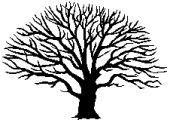
|
Elder (Ruis) 25 November–22 December
- The Elder Moon contains
the darkest days of the year.
- The day after the end
of the Elder Moon month, before the start of the Birch
Moon, is no month at all, but an “in between” day.
Nameless Day: 23 December
- The Elder Moon’s
qualities include death and regeneration, the Crone
phase of the Goddess, wisdom, transformation, and the
Underworld.
- Elder is sacred to
Wiccans. Elder shows the path through the maze, the
spiral path that leads within, and the meeting place
where birth and death are one.
- The Celts believed that
the elder could never be cut unless permission was asked
of the trees.
- Wiccans believe Elder
should never be burned in the cauldron.
|
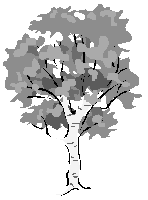 |
Birch
(Beth) 24 December–20 January
- The birch tree was a
totem tree of Celtic shamans. It was seen as their
“World Tree,” the axis upon which the universe spun.
- Birch is associated with
the Winter Solstice.
- Birches often grow at
the edge of woods, being the first to sprout up on new
ground, breaking down the soil so that the less hardy
strains can spread pout and thrive later.
- Qualities associated
with birch include inception, fertility, conception,
cleansing, purification, birth and rebirth.
- The twigs of a witch's
besom or broom are most often made of birch which is
thought to remove astral debris from the circle’s edge.
- The birch is also the
home of Robin Redbreast who captures the Wren on Dec.
26, Wren's Day.
|
 |
Rowan (Luis) 21 January–17
February
- Rowan, or mountain ash,
is a potent tool for divination. Collect rowan sprigs
during the Rowan Moon to use as catalysts during your
divination exercises.
- The Druids inscribed
symbols onto rowan rods. These were scattered about as a
question was asked, and the varied patterns created by
the fallen sticks determined the answer.
- Rowan is associated with
the festival for
Imbolc.
It is a member of the apple family, and if you cut
across the berries horizontally, a tiny, pentagram-shaped
seed container will be revealed, much like a wee version
of the one found inside an apple.
- Rowan’s qualities are
protection, magic, intuition, a protector against
enchantment, and as a guard of the sacred gateways into
the Otherworld.
- Leafy rowan twigs bound
with red ribbon were often placed in stables and biers
to protect livestock.
|
 |
Ash (Nuin) 18 February–17
March
- To the Celts, ash was a
wood of balance, containing energy from which wands of
personal power were crafted. This is because ash is
strong, and even its most slender limbs are hard to
break.
- To make your wand, begin
your search for an ash limb with which to make your wand
well before the Ash Moon. When you find one, sand away
its bark and dress it with a light coat of purifying
olive oil. Once the oil is absorbed, you may decorate
the wand to personal taste. To seal the wand as a tool
of personal power, one representing the center point of
all creation, dedicate it to its task under the full Ash
Moon. Visualize yourself at the center of the universe
and ask the moon’s blessing upon the wand. Hold the wand
high and see it as a conduit though which can pass all
the energy that is, was, or ever will be must pass, so
that you can use it in your magic and ritual.
- Qualities associated
with ash include wisdom and spiritual knowledge when
meditated upon.
- Oak, ash and thorn were
called the Faerie Triad.
- Ash is often used for
the shaft of a witch’s broom stick.
- When ash is cut, it
releases a red sap resembling blood.
- In Norse cosmology,
the giant ash tree — Yggdrasil — was the axis point
upon which the universe spun. Yggr was one of the many
names of Odin, and the usual interpretation is 'Horse
of Yggr', since
Odin in a sense rode the tree when he hung upon it.
The tree is repeatedly called 'the ash Yggdrasil', and
a possible reason for the choice of an ash might be
the bunches of 'keys' which hang from the branches
like bodies of tiny men, recalling the practice of
hanging sacrificial victims from trees.
- The ash has also peculiarly
wide-spreading roots, and in descriptions of the tree
its roots are said to extend to various regions of the
Underworld. The roots of Yggdrasil are said to extend
into different realms. According to the poem
Grímnismál, Hel, the abode of the dead, lay under one
of them, Jotunheim, land of giants, beneath another,
and the world of men under a third, implying that
these realms lay side by side, while that of the gods
was above, in the sky.
|
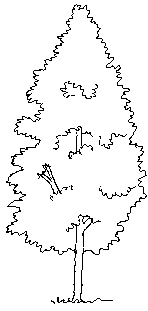 |
Alder (Fearn) 18 March–14 April
- Wood that comes from
the psychically potent alder tree has been used since
ancient times to summon spirits from the Otherworld and
to bring about desired weather patterns, particularly
storms or rain.
- Alder represents
defence and protection, yet it has a watery intuitive
side as well. It is thought to bring spiritual
perception and is associated with the Celtic Bran
the Blessed and his raven.
- European folklore tells
us alder trees must never be cut of their power will
return to the ground. You will need, instead to find a
small alder branch that has fallen to the earth. When
you have one, empower it to use in weather rituals.
- To empower your alder
wand: on a sunny afternoon during the alder moon go
outside to an isolated and twirl the branch in the air
until it whistles. Mimic the sound as summon the wind or
rain. Winds from the four elemental directions can be
catalysts for specific magical needs, and rain can be
used fro water magic or to nourish the land.
- Keep your alder wand
wrapped in cloth and hidden from view when not in use.
Recharge it each year on the full Alder Moon.
|
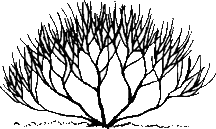 |
Willow (Saille) 15 April–12 May
- The Willow Moon offers
us the opportunity to heal spiritual and physical ills.
Like the willow, we can bend much more than we realize,
without breaking, and then bounce back again, renewed
and ready to go forward.
- The willow tree has been
used for many magical spells and rituals, and the
ancients knew the tree as a healer of great power. Its
bark is a source of salycic acid, which is the main
ingredient in aspirin. A cup of willow-bark tea helps
heal pain and fever.
- Meditating on willow is
thought to bring a sense of deep connection with the
Goddess. It is associated with clairvoyance, intuition
and emotions.
|
 |
Hawthorn (Huath) 13 May–9 June
- Hawthorn, or
whitethorn, is associated with the festival of Beltane
(although some sources list willow for Beltane).
- Hawthorn is often
associated with faeries.
- Both Celts and Wiccans
believe it is unlucky to bring hawthorn blossoms
indoors. The only time one should break or cut hawthorn
branches is on Beltane
Eve.
- Hawthorn is linked with
the bridal link of the Goddess and uninhibited
sexuality.
- Places where hawthorn
grows profusely often seem to mediate earth energies and
evoke a connection to ancient times when people were
more in tune with the land.
|
 |
Oak (Duir) 10 June–7 July
- Oak is often associated
with the summer solstice. It represents strength,
endurance, fortitude, fatherhood, the God and loyalty.
- The oak tree is also
the “door” between the light and dark halves of the
year. The oaken doorway is a gateway to the Otherworld.
- The oak was sacred to
the Druids because of its tendency to attract
lightening, survive the lightening strikes, and
regenerate afterwards. It is also symbolic of male
potency in the form of mistletoe. Even in the dormancy
of winter, this new life sprouts from its branches with
berries of white that symbolize the semen of the Lord of
the Forest.
- Use the power of the Oak
Moon to renew your commitment to your deities and
spiritual path. For this ritual, you will need three
acorns and six candles. Under the moonlight, charge the
acorns to represent your body, mind and spirit. Light
each candle to represent the six remaining moons of the
lunar year call out to your deities and rededicate
yourself to them and their service. Ask for the strength
you need to continue on their path throughout this year,
or to change the direction of your path to correct and
error in your ways. Bury the acorns to symbolize the
planting of your rediscovered commitment.
|
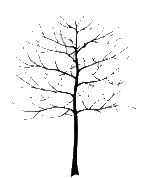 |
Holly (Tinne) 8 July–4 August
- Holly guards the door
to the inner realms. It is associated with Lammas.
Holly’s qualities include courage, war-like instinct,
male sexuality and male energy.
Just as the Holly and Oak kings battled at Yule, they
again battle for supremacy now; but this time it is the
Holly King, God of the Waning year, who will win.
- Winter Solstice
traditions also include
Robin Redbreast, who lives
in the birch, and captures the Wren, who lives in the
holly (or in some traditions in ivy), on Dec. 26, Wren's
Day.
|
 |
Hazel (Coll) 5 August–1 September
- Wood from the hazel
tree was used by the Celts for making divining rods, for
protection from storms and as emblems of authority for
Druid priests.
- The tree was seen as
feminine in nature, and with the Hazel Moon falling at
the end of autumn it came to represent the growing
wisdom as the Goddess gradually turned from living
mother to wise old crone.
- As the hazel moon begins
to wan, go out doors to a place where can see the crones
waning crescent riding low in the sky. Take with you
some diluted rosemary oil or rosemary water. Rosemary is
an herb associated with knowledge and protection. Face
the waning moon ask the crone Goddess to bless you with
her wisdom as you anoint yourself with the rosemary.
- Hazel
is associated with mental alertness, quickness, agility,
calculation and measurement, divination, poetry and
creativity.
- Dowsing
rods — used to find both water and ley energy — are
usually hazel.
|
 |
Vine (Muin) 2 September–29
September
- The Vine Moon bridges
the Autumn Equinox and takes us into the dark time of
the year, and thus has many associations with looking
inward to find creativity within ourselves.
- The vine is associated
with the festivals of Mabon and the Autumn Equinox. Its
qualities include prophecy, psychic development,
tenacity, unification and ecstasy.
|
 |
Ivy (Gort) 30 September–27 October
- Although not a tree,
ivy is so resilient and strong that it is used as a
binding catalyst in most magical systems.
- Ivy may be used to
exorcise that which we wish to banish or to unite
like-minded people.
- If used to banish, burn
ivy to the ground following the ritual to dispel any
energies of discord it may have absorbed while helping
you.
- There is great wisdom
in ivy, and it is one of the plants most sacred to the
Goddess; and places where ivy grows in abundance are
filled with dark, enthralling mystery.
- Winter Solstice
traditions also include
Robin Redbreast, who lives
in the birch, and captures the Wren, who lives in the
holly (or in some traditions in ivy), on Dec. 26, Wren's
Day.
|
Oh, the oak and the
ash and the bonnie ivy tree,
all flourish at home in my own country.
Yorkshire Folk Song

|

